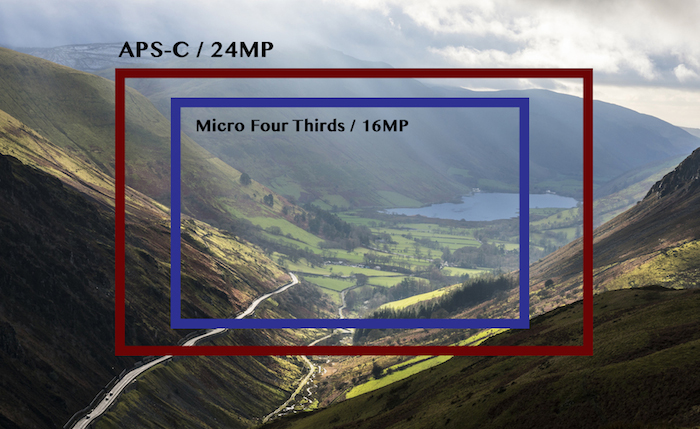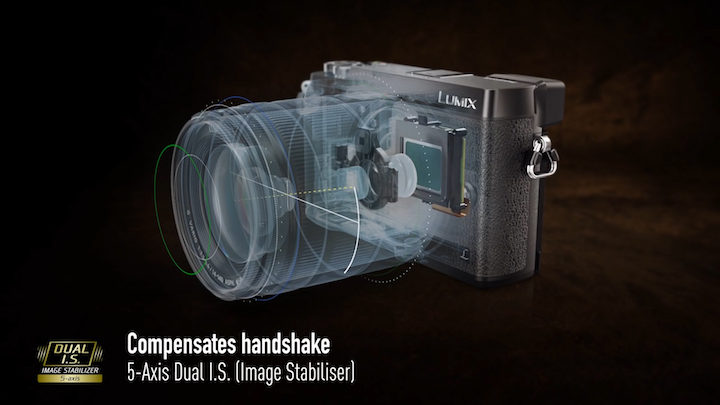
Two of the most popular mirrorless cameras at the moment are the Sony a6300 and the Panasonic GX85 (also known as the GX80 in the UK), both of which were released earlier on this year.
Like many of today’s mirrorless cameras, the a6300 and the GX85 have much in common. Both have a compact body constructed in the modern rangefinder style with the built-in electronic viewfinder on the left. The one on the a6300 is slightly larger and has an OLED panel while the GX85 uses field sequential technology.
They both come with a 3-inch LCD screen that tilts up 90 degrees and down 45 degrees, a handy silent shutter mode, a built-in flash and an EVF/LCD with an uninterrupted Live View at certain continuous shooting speeds. The a6300 can shoot up to 11fps (without live view) and up to 8fps with live view, while the GX85 goes up to 8fps and 6fps with live view.
But perhaps the most important characteristic they share is the ability to shoot high quality internal 4K video in addition to Full HD, a capability that makes both models an interesting choice for videographers looking for a compact and portable solution.
So, now that we’ve covered the main similarities, let’s have a look at the key characteristics that set the Sony a6300 and Panasonic GX85 apart.
Note: This is a comparison preview, not a complete comparison between the two models. If we get the chance to use both cameras at the same time for an extended period, we will perform an in-depth comparison.
Update: The complete comparison between the a6300 and GX85 is now online!
Ethics statement: The following list is based upon our experience with Sony and Lumix cameras and official specifications. We were not asked to write anything about these cameras, nor were we provided any compensation of any kind. Within the article, there are affiliate links. If you buy something after clicking the link, we will receive a small commission. To know more about our ethics, you can visit our full disclosure page. Thank you!
1. 24MP APS-C vs. 16MP Micro Four Thirds

The a6300 has an APS-C sized sensor with 24MP of resolution. Thanks to its copper wiring, it is capable of outperforming previous Sony models and most competitors, including the GX85, at the higher ISO values.
The GX85 has a Micro Four Thirds sized sensor with 16MP of resolution. Due to the removal of the anti-aliasing filter in front of the sensor, Panasonic claims that it offers 10% more resolution than previous 16MP Micro Four Thirds sensors.
Although a difference in image quality is there, it isn’t enormous. The a6300 has an advantage at the higher ISO values (from 6400 especially) and dynamic range. The GX85 remains an excellent performer and we’ve had no trouble using it for a variety of applications.
2. Phase Detection vs. Contrast Detection Autofocus

A significant difference between the two cameras is their respective autofocus systems.
The a6300 has the fastest and most reliable autofocus system of all mirrorless cameras. Incorporating an advanced 4D FOCUS™ hybrid autofocus system with 169 contrast detection points and 425 phase detection points across the entire surface of the sensor, the camera is able to track subjects regardless of where they move within the frame. It also features a new mode called High-density tracking AF that activates a large number points around a subject to track it more effectively.
The GX85 uses Panasonic’s Depth from Defocus (DFD) autofocus technology which was first introduced on the GH4. Since it is a contrast detection autofocus system (with 49 areas), it doesn’t work as well as Sony’s hybrid autofocus system for tracking but it is reliable enough for slow-moving subjects and is also very fast in single point mode.
As you might have guessed, the results are the same for video. In the clip below, you can see a comparison between the AF performance of the two cameras as they track a moving subject at minute 1:39.
If I only shot sports, action and wildlife, there is no question that I would choose the a6300 over the GX85.
Tip: Also keep in mind that you can adapt third-party DSLR or A-mount lenses to the a6300 without losing access to the phase detection points. For DSLR lenses from the likes of Canon and Nikon, you’ll need an adapter like the Metabones IV whereas A-mount lenses require the Sony LA-EA3 adapter. This is not possible on the GX85.
3. Touch sensitivity

Although both cameras have a 3-inch tilting LCD screen, only the GX85’s screen is touch sensitive. This is a huge advantage for both still and video shooters because you can use the screen to perform a number of actions, including:
- choosing an autofocus point / taking a picture
- choosing your settings on-screen
- scrolling through the menu
- scrolling through your images in playback mode
A good example is the GX85’s new 4K Live Cropping mode. In this mode, you can use the touch screen to select a start and end zone for panning or zooming, and start the recording. You can see a video below that shows how Live Cropping works.
It is somewhat baffling that Sony failed to give the a6300 a touchscreen, especially since the entry level a5100 has one.
4. Weather Resistance
One of the only modifications made to the a6300 body in comparison to that of the a6000 is the addition of dust and moisture resistance. By contrast, the GX85 lacks all weather-resistance, which was probably to make the camera more affordable.
5. In-Body Stabilisation

The GX85 is the first Panasonic body to feature in-body 5-axis sensor stabilisation. On its own, it works very well with lenses that lack optical stabilisation, but when combined with the optical stabilisation of select Panasonic lenses using a system called Dual IS, it provides incredible stability. To see just how well it works, check out the in-depth video comparing the GX85 and Pen F stabilisation below.
Sadly, the a6300 doesn’t have any built-in stabilisation system, leaving users with no option but to rely on the optical stabilisation of Sony lenses. Sony probably felt that it was unnecessary to add to the cost of the a6300 by giving it in-body stabilisation because, being a sports and action camera, it is meant to be used at fast shutter speeds. Still, it is a shame as the a6300 is also an excellent video camera and could benefit from in-body stabilisation for hand-held video shooting.
6. Picture Profiles for Video
Filmmakers who own the a6300 can take advantage of its dedicated picture profiles (nine in total) designed for video, including S-log2 and S-log3. These profiles provide up to 1300% more dynamic range and softer colours when graded in post production, allowing for more flexibility than the standard profiles used for stills. The S-log3 gamma setting in particular will increase the dynamic range, offering an impressive 14-stop latitude.
The GX85 does not have any log gamma or cine-like profiles, so you are limited to the standard profiles designed for stills. The only Panasonic Lumix camera to have log gamma for video is the flagship GH4.
Once again, you can see how the picture profiles of the a6300 and the standard profiles of the GX85 compare in the clip below.
7. 120fps Slow Motion Capabilities
In addition to 4K, you can also record at up to 120fps (100fps in PAL format) in Full HD with the a6300. In the normal movie mode, the camera records at 100mbps but you must conform the footage in post production to produce the desired slow motion effect.
There is also an HFR mode that allows you to record 4x/5x slow motion movies internally when the frame rate is set at 30p (25p) or 24p. However the bitrate is lower (16mbps).
The GX85 has no such feature, though it is possible to create slow motion footage by recording at 60fps and conforming it in post production.
8. Extra features
One thing I love about the GX85, and all Panasonic cameras, is that they come loaded with extra photography and video related features. There are quite a few on the GX85, so I’ll list them below:
- 4K Photo: Grab a still image from 4K footage shot at 30fps. (JPG only)
- Time Lapse: Take a time lapse video in-camera.
- Stop Motion Animation: Take a stop motion animation in-camera.
- 4K Live Cropping: As described above, this feature lets you zoom and pan in-camera by cropping a portion of the frame. It produces a Full HD video.
- Post Focus: Choose your focus point after taking the image.
- Live Composition: Good for light painting but works with 4K Photo only which can hamper the quality at high ISOs.
- Multiple exposure: Take a double exposure or more in-camera. (JPG only)
- Panoramic shooting: Take a panorama in-camera. (JPG only)
- WiFi connectivity: Connect your camera to your smartphone and control it wireless / transfer images.
The a6300 has a couple of these features, such as WiFi connectivity and Panorama, but most extra functions must be purchased from the Sony app story, which is somewhat unfair given that you’re already paying around $1000 for the camera body.
9. Battery Life
A smaller difference is the battery life of the two cameras. When we used each model individually, we found that the GX85’s battery lasted longer, especially when shooting 4K video.
For a full day of video shooting, we would bring around 5-6 batteries with us for the Sony, and only 2-3 batteries for the GX85.
10. Price
Finally, we arrive at the price. For the body alone, the a6300 costs around $1000 while with the kit lens, you’ll end up shelling out around $1150. The GX85 costs less, at around $800 with the kit lens.
Conclusion
From what we’ve seen here, it may sound like the Sony a6300 is the better camera, and in purely technological terms, it probably is. In addition to having the most advanced autofocus system on a mirrorless camera, it also enjoys a larger sensor with more resolution and better low-light performance, slow motion capabilities up to 120fps, picture profiles for video, and weather resistance.
However, the Panasonic GX85 is anything but the “loser” in this comparison. Not only does the camera offer incredible 5-axis in-body stabilisation that allows you to shoot hand-held and keep your ISO values low in poor light, but it also has a touch sensitive screen, as well as many extra features that you’d have to purchase from the Sony app store for the a6300. And all this comes at a very competitive price.
Check the price of the Sony a6300 and Panasonic GX85 at B&H Photo
